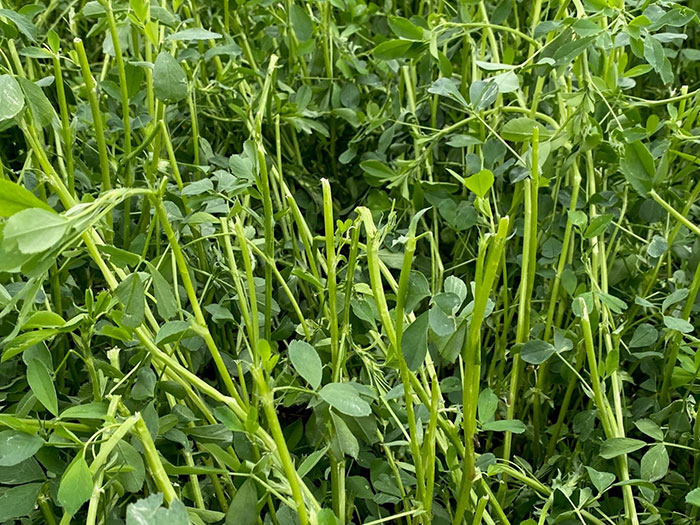Hail wreaks havoc on alfalfa |
| By Amber Friedrichsen, Associate Editor |
|
Photo: University of Minnesota |
|
Photo: University of Minnesota With a historically dry start to the summer, farmers would probably appreciate any form of rain in their forage stands. A light sprinkle, a steady shower, or a full-blown thunderstorm could all benefit plant growth at this point — unless the precipitation is accompanied by hail. According to Craig Sheaffer, extension forage agronomist, and Tyler Rice and Troy Salzer, extension educators, hail stones typically range from pea- to baseball-sized, although they can be as large as a softball. While larger hail stones cause the most damage to alfalfa, the extension specialists with the University of Minnesota explain the extent of plant injury also depends on hail stone mass and wind speed. Damage data Alfalfa primarily grows from its uppermost growing point, the apical meristem, which is responsible for stem elongation and leaf and flower development. The extension specialists note hail damage to the apical meristem will cease stem elongation, and as a result, regrowth can only occur from axillary buds located on plant stems or crowns. In addition to growing patterns, hail damage to the tops of plants can cause significant dry matter loss, especially in less mature forage. For example, injury to the top 8 inches of alfalfa in early bud stage can cause as much as a 60% yield decline, whereas the same amount of hail damage to alfalfa in the flowering stage may only lower yields by 30%. Forage quality also drastically declines when the tops of plants are injured by hail. To quantify this, the extension specialists collected samples of alfalfa in early bud stage that experienced hail damage to the upper one-third of plant stems. The samples were then analyzed for leaf area, crude protein, neutral detergent fiber (NDF), NDF digestibility (NDFD), lignin, and ash content. The extension specialist compared test results of whole plants that avoided hail damage to those that were subject to it. Whole plants comprised roughly 56% leaves, whereas damaged plants were approximately 35% leaves. Consequently, this leaf loss translated to a 6% drop in crude protein content between whole plants and damaged plants. Another effect of leaf loss is elevated NDF due to a greater proportion of stem material. In the study, NDF levels rose from 40% in whole plants to 50% in hail-damaged alfalfa. For this reason, lignin concentrations were also higher in damaged plants than whole plants at 7.8% and 5.5%, respectively. The extension specialists also collected data from plant material left on the ground after the hailstorm. Nearly 85% of this material was leaves, which further reinforces the lower quality of hail-damaged alfalfa. Harvest methods differ There are different methods for harvesting alfalfa after a hailstorm, depending on what growth stage plants are in. For example, if forage is within two weeks of harvest and more than 50% of terminal buds have been injured, the extension specialists advise removing alfalfa immediately. On the other hand, if less than 50% of terminal buds are injured, harvest can proceed as planned. Sometimes hail damage can cause lodging in alfalfa. In this case, delay harvest by three to four days to allow plants to recover. If injured alfalfa is not close to harvest, wait for regrowth to occur from new shoots and axillary buds. Then, harvest forage when it reaches adequate height and desired quality. |

